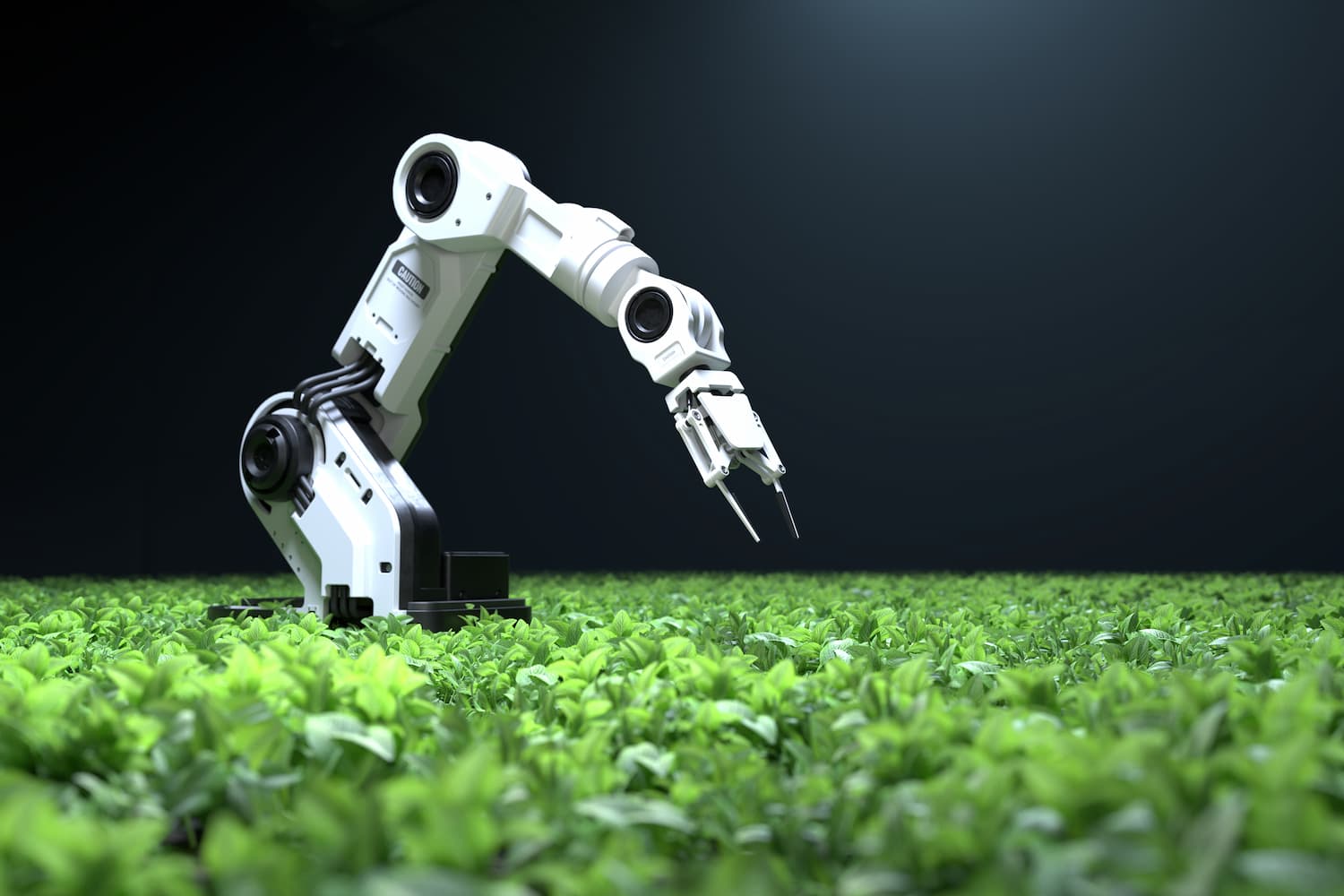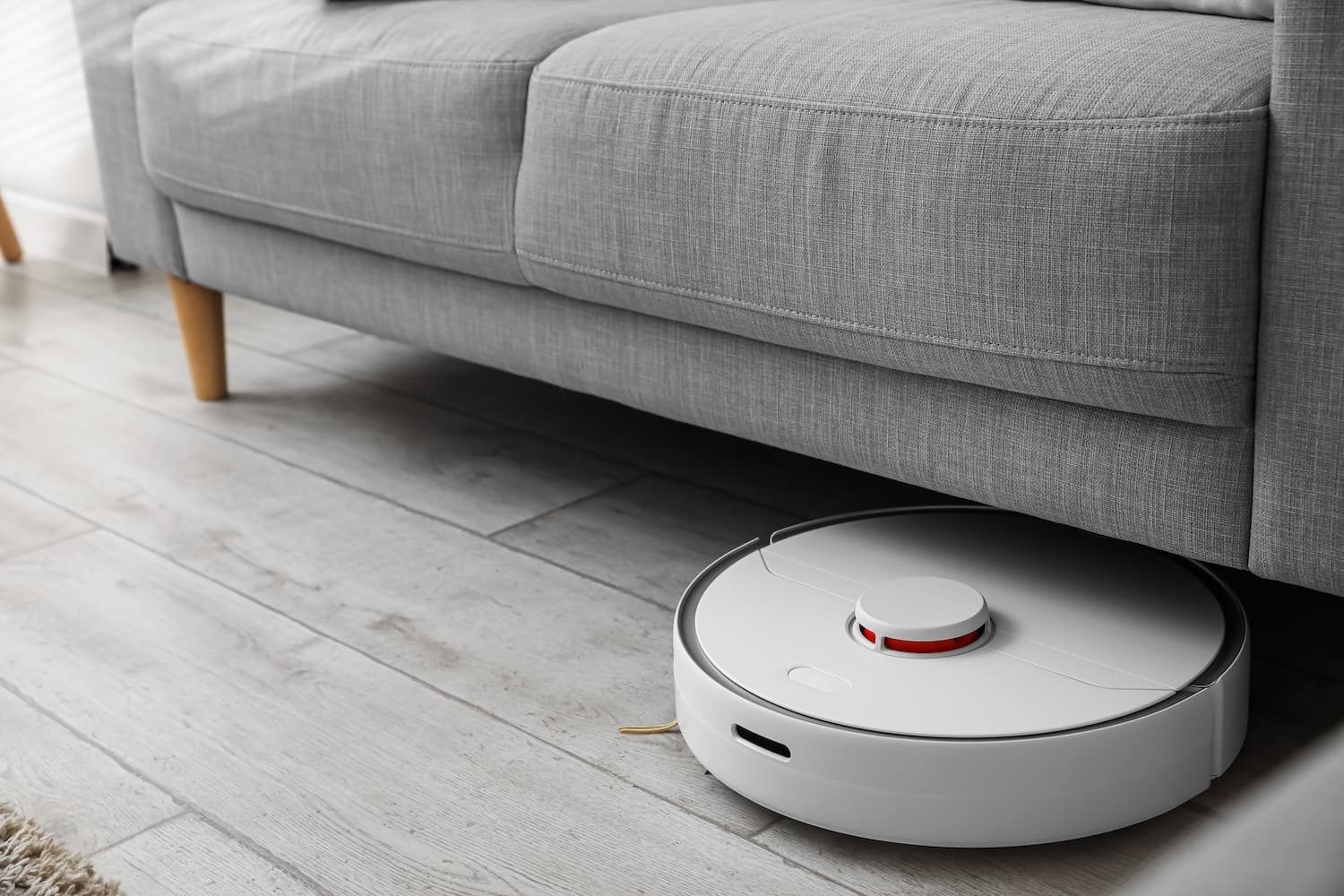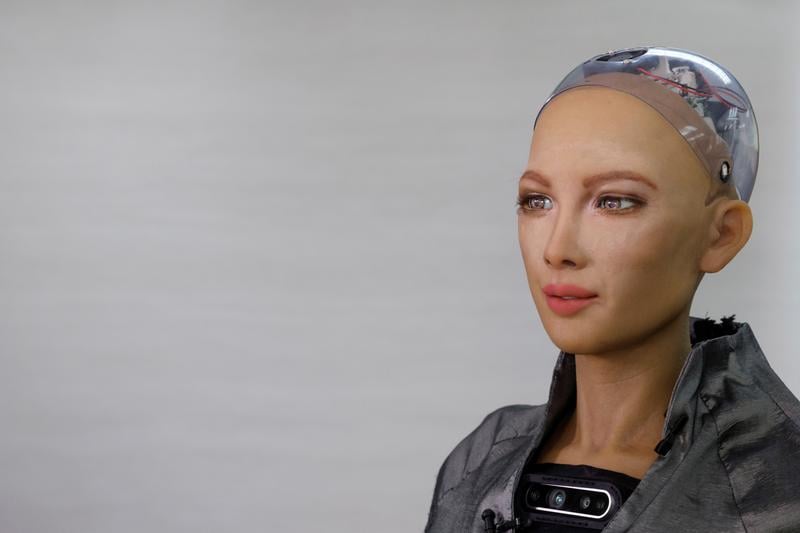Robot interview:
Everything recruiters need to know
In this guide, we look at the emergence of robots, and how a robot interview can assist HR teams with creating a more efficient recruitment process.
Introduction
In 1988, scholars were already writing about how artificial intelligence (AI) no longer was an academic term, but becoming a reality in many organizations. Today, AI technology is not only helping enhance the employee experience but changing the ways HR teams are dividing their time, as many low-value and repetitive tasks can be automated with the help of conversational virtual assistants. But AI is not one monolithic term but needs to be seen in a more nuanced way. In this guide we will take a closer look into how AI robots were developed, the different kinds of AI software systems that exist and how recruiters can benefit from implementing new AI technology.
Due to the nature of the topic, this page will be updated with new developments and research continuously.
What is an AI robot?
An AI robot is a physical, or embodied AI. An AI robot could therefore look and act in various ways. As long as it is driven by AI and has a physical "body", it is classified as an AI robot. This definition creates a variety of AI robots, from robot vacuums to human-centered social robots. Depending on the physical structure and how complex the AI technology is, will determine the kind of abilities the AI robot has.
"The screening interview should be convenient, rewarding and efficient for candidates."
- Sinisa Strbac, Chief Product Officer at Tengai
What is a robot interview?
An interview conducted by a robot is called a robot interview. A robot interview is usually implemented by recruiters who aim to automate one or several parts of the recruitment process. It is important to keep a lookout for algorithm bias, as they can negatively affect the hiring outcome.
.jpg)
Different types of AI technology
AI can be classified depending on the degree of complexity, with more intelligent systems potentially offering better functionality, as they can integrate more data. Scholars Andreas Kaplan and Michael Haenlein (2019) have developed an AI implication framework for organizations, which can be used to classify AI complexity in selection processes They suggest three stages of artificial intelligence:
1. Artificial Narrow Intelligence (ANI)
- Weak, below human-level AI
- Applies AI only to specific areas
- Unable to autonomously solve problems in other areas
- Outperforms/equals humans in the specific area
2. Artificial General Intelligence (AGI)
- Strong, human-level AI
- Applies to several areas
- Able to autonomously solve problems in other areas
- Outperforms/equals humans in several areas
2. Artificial Super Intelligence (ASI)
- Conscious/self-aware, above human-level AI
- Applies AI to any area
- Able to solve problems in other areas instantaneously
- Outperforms humans in all areas
Classifying AI systems
Kaplan and Haenlein (2019) also suggest that AI technology can be compared to human capabilities and classified depending on the systems business use.
| Analytical AI | Human Inspired AI | Humanized AI | Human Beings | |
| Cognitive Intelligence | ||||
| Emotional Intelligence | ||||
| Social Intelligence | ||||
| Artistic Creativity |
Analytical AI has only characteristics consistent with cognitive intelligence. These AI systems generate a cognitive representation of the world and use learning based on past experience to inform future decisions. Most AI systems used by firms today fall into this group and examples include systems used for image recognition, or self-driving cars. Analytical AI applications are also used in human resource management to help with the screening of CVs and selection of candidates in the form of advanced application tracking systems (ATS).
Human-Inspired AI has elements from cognitive as well as emotional intelligence. These systems can, in addition to cognitive elements, understand human emotions and consider them in their decision making. Human-inspired AI is used by the U.S. Army in the recruitment of future soldiers through an advanced SGT Star AI system that is rumored to be able to recognize emotions. The Swedish candidate screening robot Tengai, is another example of a human-like AI that can respond to questions and assess candidates personality traits through an interactive interview.
Humanized AI shows characteristics of all types of competencies (i.e., cognitive, emotional, and social intelligence). Such systems, which would be able to be self-conscious and self-aware in their interactions with others, are not available yet. While progress has been made in recognizing and mimicking human activities, building AI systems that actually experience the world in a fundamental way are a project for the (potentially distant) future.

The origin of AI robots
Many of the most significant advances in artificial intelligence have their origin in a university context. Given the technical nature of AI, this tendency is most likely to go on in the future. The term AI itself was coined at a workshop at Dartmouth College in 1956, organized by the computer scientist John McCarthy who later became a professor at Stanford.
But AI is today used as a general term, that refers to any kind of AI system. There is a big difference between different kinds of AI, as the previous section covered, and the robot vacuum cleaner "Roomba" is a great example of that. The Roomba represents the kind of AI that many users want. The Roomba was designed by rationalist thinking to do the job on its own, rather than by empiricist thinking that would give users a greater sense of control. But more complex kinds of AI, show the potential AI has to change our everyday lives. Particularly human-centered AI, which we explore below.

Human-centered AI
The combination of human-inspired AI and robotics is also where we can get a first glimpse into the world of humanized AI. In 1964, Joseph Weizenbaum from MIT created the first natural language processing computer program called ELIZA. The idea was to generate a program that can pass the Turing test: If a person cannot distinguish whether he/she is talking to a human or a machine, the machine exhibits intelligent behavior (Turing, 1950). Today ELIZA has evolved into Sophia, an AI-inspired robot developed by David Hanson that is so convincing Saudi Arabia granted it citizenship in 2017 (Kaplan and Haenlein, 2019).

According to Ben Schneiderman (2022), human-centered AI systems should be designed to be supertools which amplify, augment, empower, and enhance human performance. They should emphasize human control, while embedding high levels of automation by way of AI and machine learning. He highlights the two central goals of AI research; science and innovation and suggests four design metaphors in his book "Human-Centered AI", for researchers, developers, business leaders and policy makers.
Schneiderman's 4 design metaphors for human-centered AI:
- intelligent agents and supertools;
- teammates and tele-bots;
- assured autonomy and control centers;
- social robots and active appliances.
In 2022, human-like social robots remain novelties, mostly confined to entertainment. Except for one interview robot, Tengai, who you can read more about in the following section.
Tengai: The unbiased interview robot
Imagine a recruiter that treats all candidates the same, always asks the same questions and doesn’t care about appearance, gender or age. Well, you don’t have to imagine because they already exist! Introducing Tengai Unbiased, the social AI robot who is programmed to conduct objective job interviews. Tengai is unique and a very effective recruitment tool because it can establish a “human” connection with candidates during the job interview.
In comparison to a chatbot, Tengai’s social behavior makes behavioral realism possible. This is crucial to enhancing the candidate experience. The immersive experience Tengai creates during an interview is one of the things that makes the interview software unique. Some have questioned if Tengai would be as effective as a chatbot but the fact is, being a conversational AI robot is crucial to the immersive candidate experience.
Creating behavioral realism
Behavioral realism definition is the complete absence, or presence, of nonverbal behavior. In Tengai’s case, the focus is on how consistent the nonverbal behavior is with actual humans (e.g. eye contact). Studies show that behavioral realism is a powerful predictor of perceived social presence. Tengai’s natural behavior creates the feeling of being there with a real person, which is a crucial component of interaction. This makes the user treat the interview as reality, which contributes to a higher level of intimacy and connectedness.
Try a demo of the Tengai interview!
Try a demo interviewHR benefits from robot interviews
HR leaders are facing a radically different landscape, not just as a result of now entering the third collective year of managing a global pandemic but because an unprecedented number of workers are taking their fortunes into their own hands and opting to leave the workforce en masse in a phenomenon known as the “Great Resignation.” In fact, the most recent numbers released by the Bureau of Labor and Statistics prove that the movement is showing no signs of slowing, with an estimated 4.5 million people quitting their jobs in November 2021 alone.
With decisions to make on how to build a hybrid workforce and improve the virtual recruitment experience for global candidates while focusing on diversity and inclusion, as well, HR leaders have to explore newer avenues and technologies to get ahead — and artificial intelligence (AI) is at the forefront. AI technology is helping enhance the employee experience, as many low-value and repetitive tasks can be automated with the help of conversational virtual assistants, thus freeing up time for workers to focus on more strategic tasks for HR teams.
1. Collect objective data
To make more informed decisions, recruiters need objective candidate data. But collecting objective data is almost impossible, as our human biases will get in the way. When implementing an AI robot, recruiters get access to structured data which makes it possible to quickly identify matches between candidates and jobs, and streamline a taxing process.
2. Fair candidate experience
AI bots create great candidate experiences with brisk responses and guided instructions throughout the application process. Using AI to screen candidates, early on in the recruitment funnel, can help mitigate bias and thus contribute with a more unbiased and fair experience. The candidate user experience is crucial when it comes to recruitment because it makes candidates engage emotionally and socially, which is also proven to lead to more honest answers.
3. Increased efficiency
With the integration of one AI robot, recruiters can manage their workload better and improve their productivity. For example, SGT Star, the human-inspired AI used by the U.S. Army does the workload of more than 50 recruiters with a 94% accuracy rate and boosted engagement time for applicants from 4 minutes to over 10 minutes.
4. Private and secure
The public sector in Sweden is using more AI technology to ensure security and privacy. Because having analog processes makes it challenging to keep track of candidate data and follow GDPR regulations. The Gävle Municipality even developed a digital hiring method that collects all information in one place and assists recruiters with structured data.
5. Improve quality of hire
AI and machine learning can be leveraged to assist in this process by instantly searching through a substantial data pool to find candidates who meet the search criteria. The more the recruiter uses the AI, the more it will “learn” what outcomes the user is seeking. This technology is especially helpful in the recruitment of passive candidates. The pool of qualified passive candidates is exponentially larger than the number of applicants actively seeking an open role. Having the ability to efficiently search the entire universe of possible candidates allows for a more inclusive and effective search. Using AI to narrow a candidate pool or provide valuable data about a certain candidate group can add significant value and efficiency to recruiting. Thus, the recruiter is able to introduce more quality candidates to the process that they otherwise may not have found.

Common misconceptions about AI robotics
While AI in recruiting is becoming one of the top trends, which is transforming the traditional hiring process. There are still many misconceptions and myths about AI robots.
1. AI robots will replace humans
Today, there is empirical research that makes a strong case for AI leading to the complete automation of sourcing, screening, and matching. However, AI robots can never replace emotional intelligence which is exclusive to humans. It is therefore imperative that everyone in the corporate world realizes that AI is here only to assist recruiters. Especially since AI has the immense prowess to add value to the efficiency of recruiters and to help them manage their overwhelming workload.
2. AI robots are complicated
Another popular misconception about the integration of AI in recruiting is that AI tools are too complicated. The truth, however, is in stark contrast to this famous myth. In fact, as per Undercover Recruiter, 80 percent of recruiters assert that AI adds more efficiency and agility to their performance.
3. Recruiting with AI is expensive
This couldn't be further from the truth! Companies that have already incorporated AI in recruiting have been able to bring down the cost per hire by 35 percent. This validates the fact that AI in recruiting is not only time-effective but also cost-effective. Moreover, because AI in recruitment minimizes the prospects of hiring bad candidates, reduced cost of replacement is an indirect cost-benefit of AI in recruiting.
4. AI is only efficient for large organizations
Some people believe that AI in recruitment is only suitable for larger enterprises. But there is no proof that larger organizations would benefit more from implementing AI into their recruiting funnel. In fact, small or medium businesses will not have to think on the lines of having a big recruitment team in place given the immense efficiency added by AI. Having said that, AI in recruiting is everyone’s game to win!
Conclusion: A robot interview will help your business succeed
Using AI in recruitment can help to speed up the process by taking care of tasks like screening, skill testing and interviewing. This then frees up time for HR and Talent teams so that they can focus on other aspects of attracting and keeping employees.
Ready to start using AI in recruitment?
With Tengai, you don’t have to limit how many applicants you want to include for the initial interview. Our AI-powered recruiting software can assess a large group of applicants and objectively score their soft skills and personality traits. Our interview analytics assist recruiters in making better hiring decisions while delivering a more equal candidate experience.
Check out other resource pages
AI recruitment
Learn more about how AI can be used to reach recruitment KPIs.
Efficient screening
Everything recruiters need to know about interview screening.
Candidate UX
We asked over 3000 candidates about their interviews with Tengai




